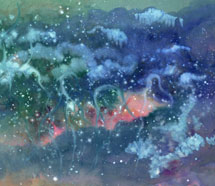
The story of Hanukkah is typical of all our confrontations in the Galut, the Diaspora. In aristocracy, each family has a coat of arms, an emblem. What was the emblem of Joseph? It was the ketonet passim, of course, the multicolored coat, a coat composed of stripes that his father made for him (Gen. 37:3). When Joseph came to Dothan, the brothers immediately stripped him of the ketonet passim, the banner that Joseph carried (Gen. 37:23). Without the ketonet ha-passim, Joseph’s power dissipated and disappeared. I believe the ketonet ha-passim is the symbol of the Jewish people as well, of the Hasmoneans and of every generation of Jews.
Joseph beheld two visions. He dreamt of his alumot, sheaves, which rose and stood up high while the sheaves of his brothers came and bowed down to his. When he told that dream to his brothers, they were not envious of that dream. True, their hatred was deepened and strengthened, but their envy was not aroused. Then he dreamt another dream. He dreamt of the sun and the moon and the stars bowing to him. When he told this dream to his father, “va-yekan’u bo echav, his brethren envied him” (Gen. 37:11)—not only did they hate him, but they were envious of him as well.
I am not a dream interpreter, but the prima facie interpretation is that Joseph had two visions. One was of material economic power, of prosperity and opulence, and that vision came true one hundred percent. The other dream apparently revolved around spiritual greatness, heavenly sweep and heavenly grandeur. Joseph wanted to be powerful in a political sense, to attain wealth and prosperity, to be respected by people because of his power, feared by people because of his might; but he also wanted to be great spiritually, to be loved by people, to be revered by people because of the greatness of his wisdom and his kindness.
Can one person combine both qualities? Can one person fulfill both dreams, the dream of the sheaves—of economic and military power—and also the dream of spiritual greatness, of moral heights and communion with God? Joseph, as an executive, paid attention to the hard facts of life; he organized the storage of the food during the seven years of prosperity. He divided and then removed the peasants from their land. Could he at the same time be a dreamer, a visionary, and a spiritual leader loved by people?
Apparently, Joseph thought that he could combine both. This is the meaning of the ketonet ha-passim—multicolored, not monochromatic, not one monotonous color. If there are many colors, there are many contradictions. Colors clash with one another, and Joseph was the synthesis of alumot and the heavenly bodies.
The Jews throughout history have imitated Joseph. We also have two visions. The Jew is a good merchant and he is skillful in trade. Jews dreamt of sheaves, otherwise they could not have survived. At the same time the Jew—the small merchant, the grocer, the peddler—would come home for the Sabbath. I knew such people in my childhood. The same Jew, sometimes in rags, had another dream—not of alumot, not of dollars and cents, of rubles and kopeks, but of something else, of a “sun, a moon, and eleven stars” (Gen. 37:9) of spiritual greatness. He was a great spiritual personality.
That synthesis is exactly what the Hasmoneans stood for. They were excellent warriors, but the very moment they laid down their swords, their interests centered around kedushah, holiness, around the oil for the menorah which burned in the Temple, of “purification of the entire Temple and the dedication of the altar” (II Macc. 2:19).
Excerpted from Day of Deliverance: Essays on Purim and Hanukkah by Rabbi Joseph B. Soloveitchik.
More information on the book can be found here: OU Press
The words of this author reflect his/her own opinions and do not necessarily represent the official position of the Orthodox Union.

